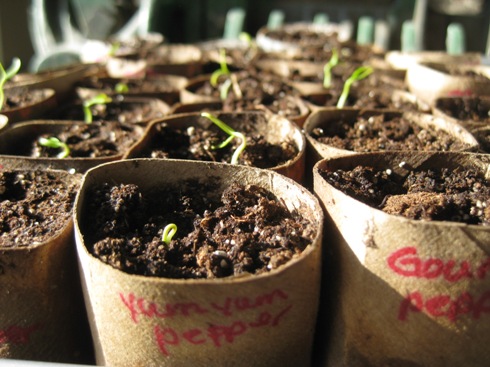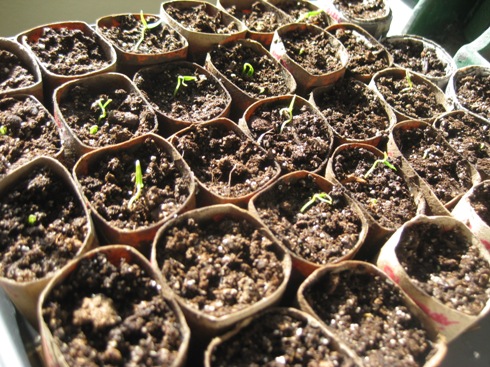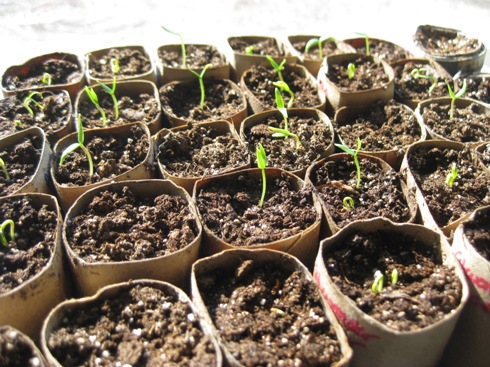They are going like gangbusters! Peppers usually take 8-25 days to germinate, and I got almost all of mine to germinate in about 7 days by putting them on an old cookie sheet on top of a heating pad set on low.

Every year, and with every seedling, I am always amazed by how quickly they grow. Here they are on Monday afternoon:

And here they are on Tuesday afternoon. Isn't that amazing?

Now aren't you totally psyched about starting seeds for your own garden this year?
Now, on with the important information. The first gardening class on Monday was on getting the most out of your vegetable garden. Dr. Swift covered designing gardens, selecting the proper plants, determining correct plant spacing and plant yield, using raised beds and containers, selecting irrigation systems, starting transplants, and planting times for cool- and warm-season vegetables. He had some great handouts, which are available on his website if you're interested.
One of the best things I learned was about blossom-end rot on tomatoes. For the last two years I have struggled with this particularly in my roma tomatoes, and last year I also had some rot on the side walls of my peppers. I was always told that this was due to a lack of calcium in the soil. However, Dr. Swift said it is actually due to an inability of the plant to take up the calcium present in the soil, and this is due to the plant getting stressed by too much heat (more than 90 degrees for tomatoes) and/or soil that is too dry. Good to know for this year!
Tuesday's class was on composting. Rather than dealing with a compost pile that must be turned, Dr. Swift is a fan of trench or pit composting. For trench composting, you dig a trench about 18" deep in an unused part of your garden and add your compostable materials to it, covered by about 3 inches of soil, filling in the trench a little at a time over the summer. You leave the trench undisturbed for the year, and the next season you can plant your vegetables right in that trench area. By that time the worms and other good things in the soil have broken down the material into good compost. He recommended pit composting around perenneals and trees: use a post-hole digger to dig a hole about 18" deep, fill with compostable material, cover with a few inches of soil, and let the earthworms go to town on it. That sure beats turning a compost pile every few days!




Oh baby...You are on a roll! I can't wait to see your garden this summer! I am officially done with plants (pouting)...I have lost so many of my tropical trees from this winters freeze. sad sad sad!
ReplyDeleteThose little sprouts look fantastic! Too bad I have a tiny apartment with no space for growing anything (except dust bunnies).
ReplyDeleteAlso I'm not sure if you follow Cute Overload, but I saw this post this morning and immediately thought of you:
http://cuteoverload.com/2010/02/23/an-actual-wart-hog/
Oh, yeah. I can grow some wicked big dust bunnies, too!
ReplyDeleteThat little warthog is SUPER cute! :D
Oh I like the idea of a compost pit instead of struggling to turn everything over. Your little plants are really making progress! I think I would like a nice cozy heating pad near me all the time too. :-)
ReplyDeleteHi!
ReplyDeleteSandy here. Over on blustery Abbott Ave. I cannot tell you how inspiring it is to read about your gardening adventures on day like this, when the snow is swirling around and I know I'm going to be shoveling for hours. Here's my question: Did the good doctor say anything about trench composting and critters? I really want to start a compost, and the trench variety sounds ideal, but I'm concerned about the wildlife we would attract. Our neighborhood is filled with noctural goobers such as skunks, raccoons, and opossums. Not that they're not cute (except the opposums). I'd love any suggestions!
The good doctor did in fact say something about trench composting and critters! Stay tuned for a more complete compost post (say that three times fast) coming soon! (But the short answer is that it shouldn't be a problem as long as it is just plant materials and fruit/vegetable kitchen scraps and no meat or other things that could be stinky).
ReplyDelete